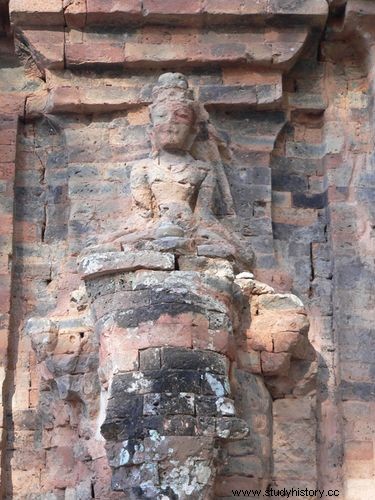Champa , Chinese Lin-yi , ancient Indochinese kingdom from 2nd to 17th centuries n . Ch. and spans the central and southern coastal regions Vietnam from the 18th parallel north to Point Ke Ga (Cape Varella) to the south. Champa was from the Cham, a people of Malayo-Polynesian descent and Indianized Culture , founded and eventually adopted by the Vietnamese, who in turn were heavily influenced by the Cham culture.

Champa was 192 n . Chr . During the decay of the Han Dynasty established in China when the Han official in charge of the region established his own kingdom around the area of present-day Hue city . Although initially inhabited mainly by savage tribes engaged in incessant battles with the Chinese colonies in Tonkin, the area gradually came under Indian cultural influence and evolved into a decentralized one Country that consisted of four small states named after regions of India - Amaravati (Quang) Nam); Vijaya (Binh Dinh); Kauthara (Nha Trang); and Panduranga (Phan Rang) - whose populations remained concentrated in small coastal enclaves. It had a powerful fleet used for trade and piracy.
Around 400 n . Chr . Champa was united under the reign of King Bhadravarman. In retaliation for Cham raids on their coast, the Chinese invaded Champa in 446 and restored the region to their suzerainty. Finally, under a new Dynasty in the 6th century, Champa cast his loyalty from China and entered an era of great independent prosperity and artistic achievement. The center of the nation began to shift from north to south; Around the middle of the 8th century, Chinese sources cease to mention Lin-yi and begin to refer to the kingdom as Huan-wang, a Sinicization of the northernmost province's name , Panduranga (Phan Rang). In the late 8th century, the Chams were ravaged by attacks from Java deflected But in the 9th century they renewed their pressure on the Chinese provinces to the north and the growing Khmer (Cambodian) empire in the West. Under Indravarman II, who founded the Indrapura dynasty (the sixth in Champan history) in 875, the country's capital was transferred to the northern province of Amaravati (Quang Nam) in near present-day Hue and erected elaborate palaces and temples.
In the 10th century, the Dai Viet kingdom of Vietnam put pressure on Champa, forcing it to abandon Amaravati in 1000 and Vijaya in 1069 . Harivarman IV, who founded the ninth Cham dynasty in 1074, repelled further Vietnamese and Cambodian attacks, but in 1145 the Khmer fell under the aggressive leadership of Suryavarman II . entered and conquered Champa. Two years later, a new Cham king, Jaya Harivarman I, rose and overthrew Khmer rule. His successor sacked the Cambodian capital in 1177 Angkor . Between 1190 and 1220 the Chams again came under Cambodian rule, and later in the 13th century they were attacked by the Tran kings of Vietnam in 1284 and by the Mongols. By the end of the 15th century, incessant wars of aggression and defense for all practical purposes wiped out the Champa kingdom; One by one their provinces were annexed until Champa was completely absorbed in the 17th century.
Its end marked the decline the only culture on the Asian Mainland with oceanic features. Cham painting is only known from the inscriptions on the temples. Influenced by Indian Gupta art, Cham sculptors developed a highly personal style characterized by forms springing with wild energy. Architecture was generally limited to stepped brick poles.
